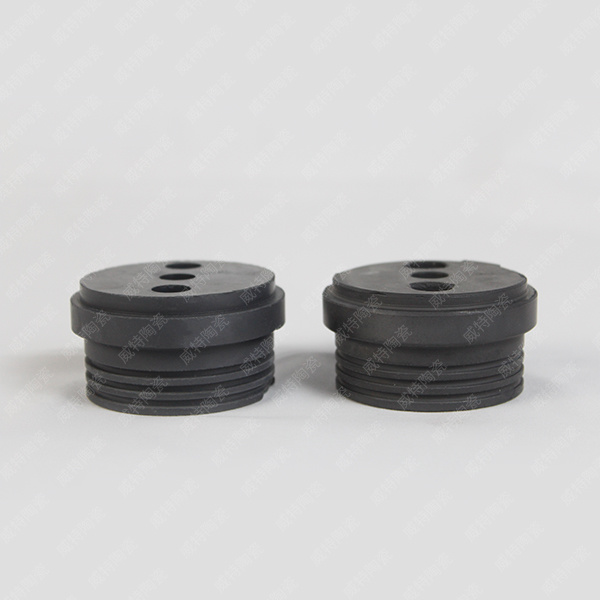
NEWS
Do you know the difference between silicon nitride and silicon carbide?
Release time:
2022-05-18
There is only one word difference between silicon nitride and silicon carbide, and many friends are easily confused. Let's briefly understand the difference between the two, shall we?

Silicon nitride is a high-melting ceramic material that is extremely hard and chemically inert. Especially hot-pressed silicon nitride is one of the hardest substances in the world. Silicon nitride ceramics have a low coefficient of thermal expansion and high thermal conductivity, so they have excellent thermal shock resistance. At not too high temperatures, silicon nitride has high strength and impact resistance, but when used above 1200°C, it will be damaged with the increase of service time, reducing its strength.
Silicon nitride is divided into pressure silicon nitride and hot pressure silicon nitride:
Gas pressure sintering of silicon nitride ceramics, the most popular method for producing high strength and complex geometries of silicon nitride components. The gas pressure sintering method uses silicon nitride powder that has been mixed with a sintering aid to facilitate liquid phase sintering (typically yttria, magnesia and/or alumina), and a binder to increase the mechanical strength of the green ceramic body. The powder is pressed into the desired shape and then green processed. The briquettes are then placed into a furnace with a pressurized nitrogen atmosphere to aid in densification and prevent evaporation and decomposition of silicon, nitrogen and additives.
Hot-press sintered silicon nitride ceramics are produced by uniaxially pressing silicon nitride powder and sintering additives while heating. This process requires special types of presses and molds. It produces silicon nitride with excellent mechanical properties. However, this form of forming can only produce simple shapes such as plates or rods. By hot-pressing silicon nitride, products with almost zero porosity can be achieved. This results in excellent mechanical properties and corrosion resistance even in high temperature applications.
From the physical and chemical properties of silicon nitride ceramics , it can be seen that the excellent performance of silicon nitride ceramics has special use value for the working environment of high temperature, high speed and strong corrosive medium often encountered in modern technology. Its outstanding advantages are:
Has the following advantages:
(1) High mechanical strength, hardness close to that of corundum. The room temperature flexural strength of hot-pressed silicon nitride can be as high as 780-980MPa, and some are even higher, which can be compared with alloy steel, and the strength can be maintained until 1200 ℃ without falling.
(2) Mechanical self-lubrication, small surface friction coefficient, wear resistance, large elastic modulus, and high temperature resistance.
(3) The thermal expansion coefficient is small, the thermal conductivity is large, and the thermal shock resistance is good.
(4) Low density and small specific gravity.
(5) Corrosion resistance and oxidation resistance.
(6) Good electrical insulation.
Silicon nitride ceramics are widely used in the field of application: (1) In the metallurgical industry, crucibles, muffle furnaces, burners, heating element fixtures, casting molds, aluminum industry conduits, thermocouple protection sleeves, aluminum electrolytic cell linings, etc. Components on thermal equipment.
(2) In the mechanical manufacturing industry, high-speed turning tools, bearings, support parts for heat treatment of metal parts, scrapers for rotor engines, guide blades and turbine blades for gas turbines.
(3) Used in the chemical industry as ball valves, pump bodies, sealing rings, filters, heat exchanger components and immobilized catalyst carriers, combustion boats, and evaporators.
(4) In semiconductor, aviation, atomic energy and other industries, it is used to manufacture switch circuit substrates, film capacitors, electrical insulators that withstand high temperatures or dramatic temperature changes, radar wire covers, missile tail nozzles, supports and separators in atomic reactors, Carrier of nuclear fission material.
(5) It can be used as an artificial joint in the pharmaceutical industry.
Silicon carbide ceramics refer to mechanical parts made of special ceramic materials through mixing, molding, sintering and processing processes. The mentioned special ceramic materials may be oxide ceramics, nitride ceramics, boride ceramics, carbide ceramics and the like. As an inorganic non-metallic material, special ceramic materials have many properties that metal materials do not have, such as: high strength, high hardness, high elastic modulus, high temperature resistance, wear resistance, corrosion resistance, oxidation resistance, thermal shock resistance .
Silicon carbide ceramics have excellent mechanical properties, excellent oxidation resistance, high wear resistance and low friction coefficient. The disadvantage of SiC ceramics is low fracture toughness, that is, high brittleness. For this reason, multiphase ceramics based on SiC ceramics, such as fiber (or whisker) reinforcement, heterogeneous particle dispersion strengthening, and gradient functional materials have emerged one after another. , improving the toughness and strength of the monomer material.
Silicon carbide ceramics are widely used, such as using ceramics with high hardness and high wear resistance to produce mechanical parts, seals, cutting tools and other materials, and using ceramics with high wear resistance, high strength and high toughness to produce wear-resistant and light-weight automotive materials. Parts, heat-resistant and heat-insulating parts, gas turbine blades, piston tops, inserts, etc., use ceramics with corrosion resistance and good chemical stability in contact with biological enzymes to produce crucibles for metal smelting, heat exchangers, etc.
Recommend




